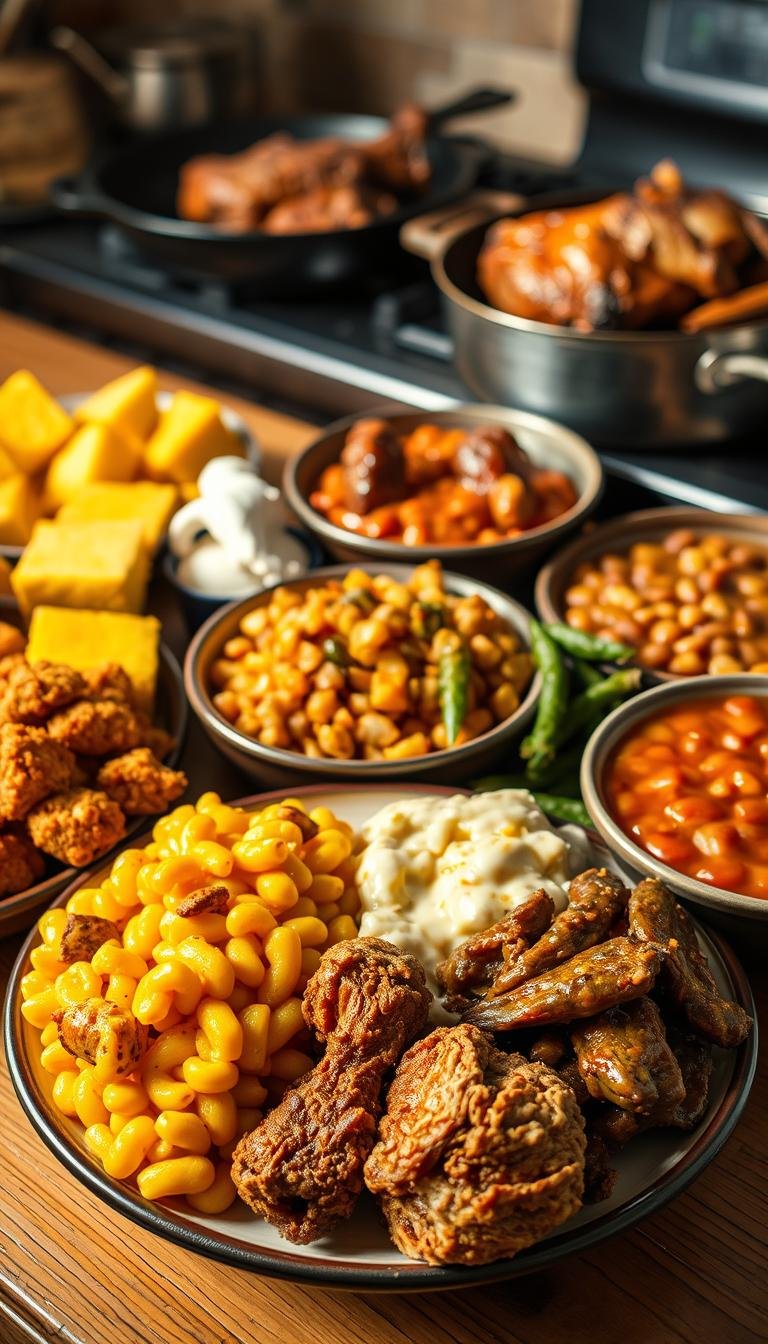25 Delicious Gluten-Free Pizza Dough Recipes
For millions of Americans with celiac disease or gluten intolerance, enjoying a traditional pizza night can be a challenge. However, gluten-free pizza is no longer a compromise on taste or texture. With the right ingredients and techniques, homemade gluten-free pizza can be just as satisfying as its traditional counterpart.
This comprehensive guide introduces you to 25 exceptional gluten-free pizza dough recipes that cater to various tastes and dietary needs. From quick and easy options to more gourmet variations, you’ll discover the perfect wheat-free pizza dough recipe for your next pizza night.
Key Takeaways
- Discover 25 unique gluten-free pizza dough recipes.
- Learn various flour alternatives for gluten-free baking.
- Explore binding techniques for perfect crust texture.
- Find cooking methods that yield crispy, delicious crusts.
- Enjoy pizza night without worrying about gluten intake.
The Joy of Gluten-Free Pizza Making
Creating gluten-free pizzas at home can be a rewarding experience that allows for complete control over ingredients and flavors. This aspect of gluten-free baking not only caters to those with dietary restrictions but also opens up a world of culinary creativity.
The process of making gluten-free pizza can become a fun family activity, involving everyone in the kitchen, regardless of their dietary needs. It’s an opportunity to be creative with different toppings and ingredients, making each pizza a personalized masterpiece. The satisfaction of creating something delicious that meets specific dietary requirements without feeling like a compromise is truly fulfilling.
One of the significant advantages of homemade gluten-free pizza is its cost-effectiveness. By choosing your ingredients, you can avoid the high costs associated with store-bought or restaurant gluten-free options. Moreover, the ability to experiment with various flours, such as almond or rice flour, and different toppings allows for a wide range of pizza experiences.
- Enjoy the freedom to choose your ingredients.
- Experiment with different gluten-free flours and toppings.
- Make pizza making a fun, inclusive family activity.
Embracing gluten-free pizza making at home brings numerous benefits, from the joy of cooking together to the satisfaction of enjoying a meal that caters to everyone’s needs. It’s about exploring the possibilities of celiac-friendly cooking and discovering the advantages of gluten-free cooking benefits.
As you delve into the world of gluten-free pizza making, you’ll find that it’s not just about substituting ingredients but creating a culinary experience that everyone can enjoy. With the right recipes and a bit of creativity, homemade gluten-free pizzas can be just as delicious as their traditional counterparts.
Understanding Gluten-Free Pizza Basics
The key to delicious gluten-free pizza lies in understanding its core components. Gluten-free pizza making involves more than just substituting flour; it requires a comprehensive approach to replicate the structure and taste of traditional pizza.
Common Gluten-Free Flour Alternatives
Various gluten-free flours can be used to make pizza dough, each with its unique properties and flavors. Almond flour, for instance, adds a nutty flavor and is often used in low-carb recipes. Cauliflower flour is another popular choice, providing a light texture and subtle taste. Rice flour and chickpea flour are also commonly used, offering different textures and nutritional benefits.
| Flour Type | Flavor Profile | Best Use |
|---|---|---|
| Almond Flour | Nutty, rich | Low-carb, keto recipes |
| Cauliflower Flour | Light, subtle | Low-carb, vegetable-based crusts |
| Rice Flour | Mild, slightly sweet | Traditional gluten-free pizza |
| Chickpea Flour | Earthy, slightly bitter | Mediterranean-inspired recipes |
Essential Binding Agents for Gluten-Free Dough
Gluten-free dough often requires additional binding agents to replicate the elasticity provided by gluten. Xanthan gum and psyllium husk are commonly used for this purpose. Eggs and flaxseed can also serve as effective binding agents, adding moisture and structure to the dough.
- Xanthan gum: Improves dough elasticity and structure
- Psyllium husk: Adds fiber and helps with dough binding
- Eggs: Provides moisture and richness
- Flaxseed: Acts as a vegan alternative to eggs, adding omega-3 fatty acids
Equipment Needed for Perfect Gluten-Free Pizza
Achieving the perfect gluten-free pizza requires the right equipment. A pizza stone can help achieve a crispy crust, while perforated pans allow for even cooking. Parchment paper is useful for preventing dough from sticking, and specific mixing equipment can help in achieving the right dough consistency.
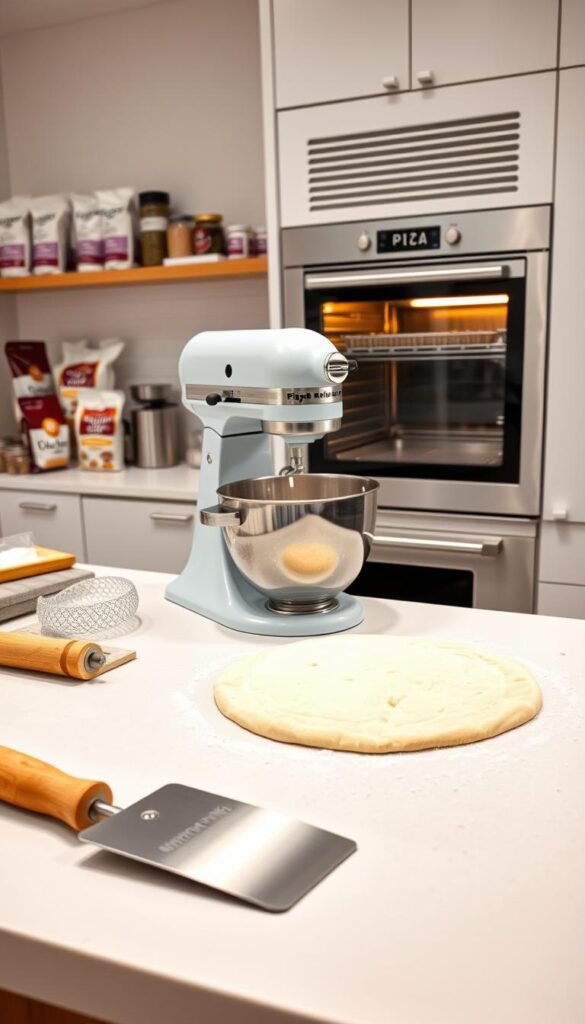
Almond Flour Pizza Dough Recipes
Almond flour has become a staple ingredient for those seeking gluten-free and low-carb pizza options. Its popularity stems from its ability to create delicious, grain-free crusts that cater to various dietary needs, including keto, paleo, and gluten-free lifestyles.
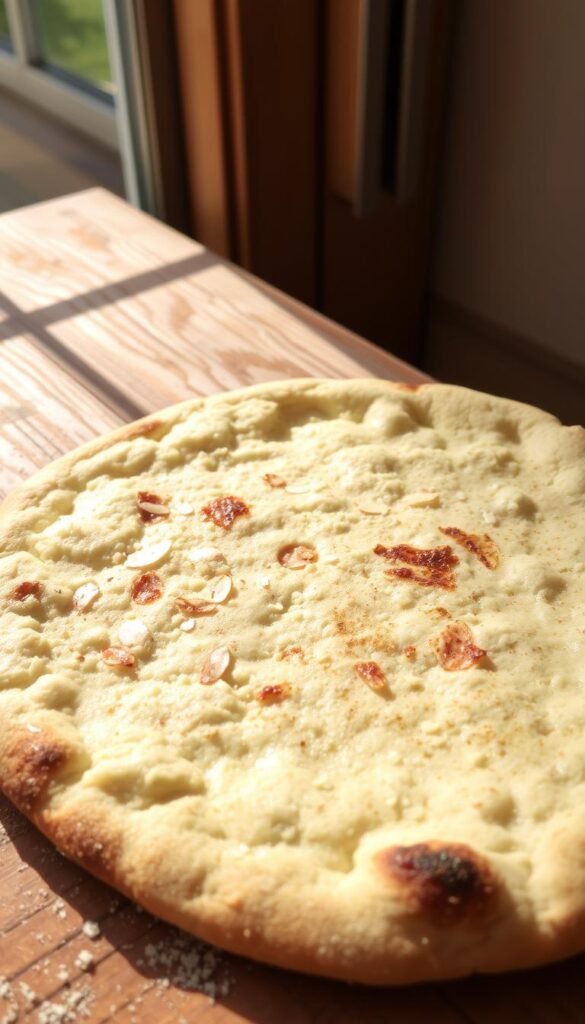
Classic Almond Flour Pizza Base
The Classic Almond Flour Pizza Base is a foundational recipe that mimics the texture and flavor of traditional pizza dough. It’s an excellent starting point for those new to almond flour pizza making.
Ingredients
- 1 1/2 cups almond flour
- 1/4 cup coconut flour
- 1/2 teaspoon salt
- 1 tablespoon olive oil
- 1 egg
Preparation Method
- Combine dry ingredients in a bowl.
- Add olive oil and egg; mix until a dough forms.
- Knead the dough for 2-3 minutes.
- Roll out to desired thickness and top with your favorite ingredients.
Almond and Coconut Flour Blend Pizza Dough
Blending almond flour with coconut flour creates a pizza dough with improved texture and flavor. This combination is ideal for those seeking a more traditional pizza crust experience.
Ingredients
- 1 cup almond flour
- 1/2 cup coconut flour
- 1/4 teaspoon salt
- 1 tablespoon olive oil
- 2 eggs
Preparation Method
- Mix dry ingredients in a bowl.
- Add olive oil and eggs; mix until a dough forms.
- Knead for 3-4 minutes until smooth.
- Shape into a circle or rectangle and bake at 425°F for 12-15 minutes.
| Recipe | Key Ingredients | Preparation Time |
|---|---|---|
| Classic Almond Flour Pizza Base | Almond flour, coconut flour, egg | 15 minutes |
| Almond and Coconut Flour Blend | Almond flour, coconut flour, eggs | 20 minutes |
| Keto-Friendly Almond Flour Pizza Crust | Almond flour, cream cheese, egg | 10 minutes |
| Herb-Infused Almond Flour Pizza Base | Almond flour, herbs, olive oil | 18 minutes |
| Crispy Thin-Crust Almond Flour Pizza | Almond flour, coconut flour, water | 12 minutes |
Keto-Friendly Almond Flour Pizza Crust
This keto-friendly recipe is designed to meet the dietary requirements of those following a ketogenic lifestyle. It uses ingredients that are low in carbs and high in fat.
Ingredients
- 1 1/2 cups almond flour
- 1/4 cup cream cheese
- 1 egg
- 1/4 teaspoon salt
Preparation Method
- Mix almond flour and salt in a bowl.
- Add cream cheese and egg; mix until smooth.
- Roll out thinly and bake at 400°F for 10-12 minutes.
Herb-Infused Almond Flour Pizza Base
Infusing your pizza dough with herbs adds a depth of flavor that’s sure to impress. This recipe combines the nuttiness of almond flour with the freshness of herbs.
Ingredients
- 1 cup almond flour
- 1/4 cup chopped fresh herbs
- 1/2 teaspoon salt
- 1 tablespoon olive oil
- 1 egg
Preparation Method
- Combine almond flour, herbs, and salt.
- Add olive oil and egg; mix until a dough forms.
- Knead for 2 minutes and shape into a circle.
- Bake at 425°F for 15-18 minutes.
Crispy Thin-Crust Almond Flour Pizza
Achieving a crispy thin crust is possible with almond flour. This recipe is perfect for those who prefer a cracker-like base for their pizza.
Ingredients
- 1 1/2 cups almond flour
- 1/4 cup coconut flour
- 1/4 teaspoon salt
- 1/2 cup water
Preparation Method
- Mix dry ingredients in a bowl.
- Add water and mix until a dough forms.
- Roll out very thinly and bake at 450°F for 8-10 minutes.
Cauliflower-Based Pizza Crusts
Cauliflower-based pizza crusts have revolutionized the way we enjoy pizza, offering a low-carb and vegetable-forward alternative to traditional pizza dough. This innovative approach to pizza making has gained popularity due to its health benefits and versatility in accommodating various toppings and flavors.
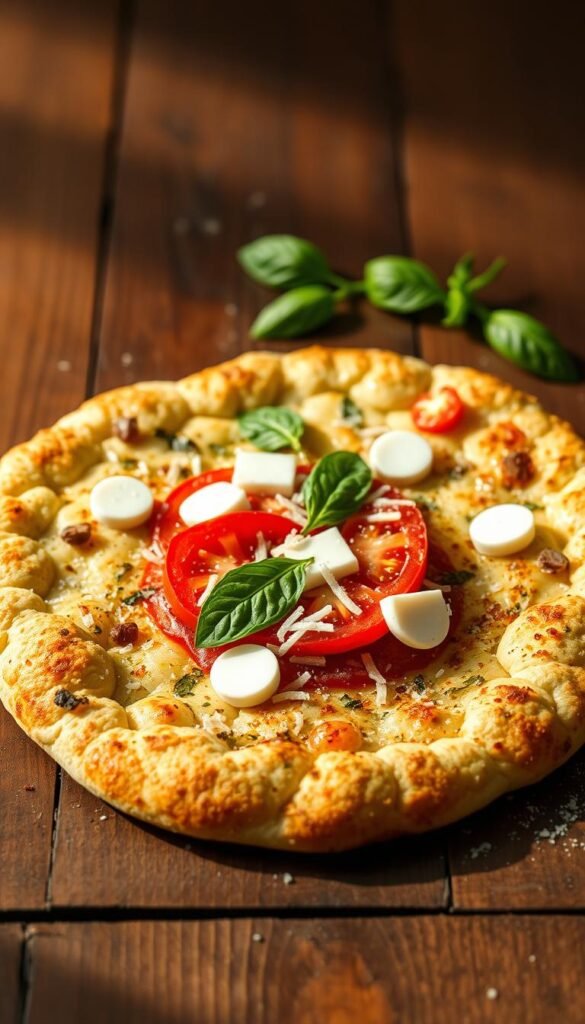
Traditional Cauliflower Pizza Crust
The traditional cauliflower pizza crust is a pioneering recipe that has made gluten-free pizza making accessible to many. It involves processing cauliflower into a rice-like consistency, cooking it, and then mixing it with cheese and other ingredients to form a dough-like consistency.
Ingredients
- 1 head of cauliflower
- 1/2 cup of mozzarella cheese
- 1/4 cup of grated Parmesan cheese
- 1 egg
- Salt and oregano to taste
Preparation Method
To prepare the traditional cauliflower pizza crust, start by preheating your oven to 425°F (220°C). Process the cauliflower in a food processor until it resembles rice. Microwave the cauliflower “rice” for 4-5 minutes until it’s soft and has a cooked consistency. Allow it to cool, then transfer it to a clean dish towel. Wrap the towel around the cauliflower and squeeze as much liquid as possible out of it. In a bowl, mix the drained cauliflower, mozzarella cheese, Parmesan cheese, egg, salt, and oregano. Spread the mixture onto a baking sheet lined with parchment paper, forming a circle or rectangle shape. Bake for 15-20 minutes or until the crust is golden brown and set.
Cheesy Cauliflower Pizza Base
Enhancing the traditional recipe, the cheesy cauliflower pizza base incorporates additional cheese for improved flavor and binding properties. This variation is perfect for those who prefer a richer, cheesier pizza base.
Ingredients
- 1 head of cauliflower
- 3/4 cup of mozzarella cheese
- 1/2 cup of grated cheddar cheese
- 1/4 cup of grated Parmesan cheese
- 1 egg
- Salt and Italian seasoning to taste
Preparation Method
The preparation method for the cheesy cauliflower pizza base is similar to the traditional crust, with the addition of more cheese to the mixture. The extra cheese not only enhances the flavor but also helps in binding the crust together, making it less prone to crumbling.
Cauliflower and Zucchini Blend Pizza Dough
Combining cauliflower with zucchini creates a pizza dough that is not only healthier but also packed with more nutrients. This blend offers a refreshing twist on the traditional cauliflower crust.
Ingredients
- 1 head of cauliflower
- 1 medium zucchini
- 1/2 cup of mozzarella cheese
- 1/4 cup of grated Parmesan cheese
- 1 egg
- Salt and basil to taste
Preparation Method
To make the cauliflower and zucchini blend pizza dough, follow a similar process as the traditional cauliflower crust, but add grated zucchini to the cauliflower mixture. The additional moisture from the zucchini may require adjusting the amount of cheese or egg to achieve the right consistency.
Spiced Cauliflower Pizza Crust
For those who enjoy a bit of spice, the spiced cauliflower pizza crust is an exciting variation that incorporates various herbs and spices into the crust, enhancing its flavor profile.
Ingredients
- 1 head of cauliflower
- 1/2 cup of mozzarella cheese
- 1/4 cup of grated Parmesan cheese
- 1 egg
- 1 tsp of dried oregano
- 1/2 tsp of garlic powder
- Salt to taste
Preparation Method
The preparation method for the spiced cauliflower pizza crust involves mixing the cooked and drained cauliflower with cheese, egg, and the chosen spices. The spices not only add flavor but can also help in masking any bitterness from the cauliflower.
Crispy Cauliflower and Parmesan Crust
Achieving a crispy crust is a common challenge with cauliflower pizza bases. The crispy cauliflower and Parmesan crust addresses this by incorporating a higher ratio of Parmesan cheese and baking the crust until it’s crispy and golden.
Ingredients
- 1 head of cauliflower
- 1/2 cup of grated Parmesan cheese
- 1/4 cup of mozzarella cheese
- 1 egg
- Salt to taste
Preparation Method
To make the crispy cauliflower and Parmesan crust, ensure that the cauliflower is drained well after cooking. Mixing it with a generous amount of Parmesan cheese helps in achieving a crispy exterior. Baking the crust in a preheated oven at a higher temperature can also aid in crispiness.
Rice Flour Pizza Dough Variations
Rice flour pizza dough variations provide a delicious alternative to traditional pizza. Rice flour, being a staple in gluten-free baking, offers a neutral flavor profile that closely mimics the taste of traditional wheat-based pizza dough. This section will explore five different rice flour pizza dough recipes, each with its unique characteristics and advantages.
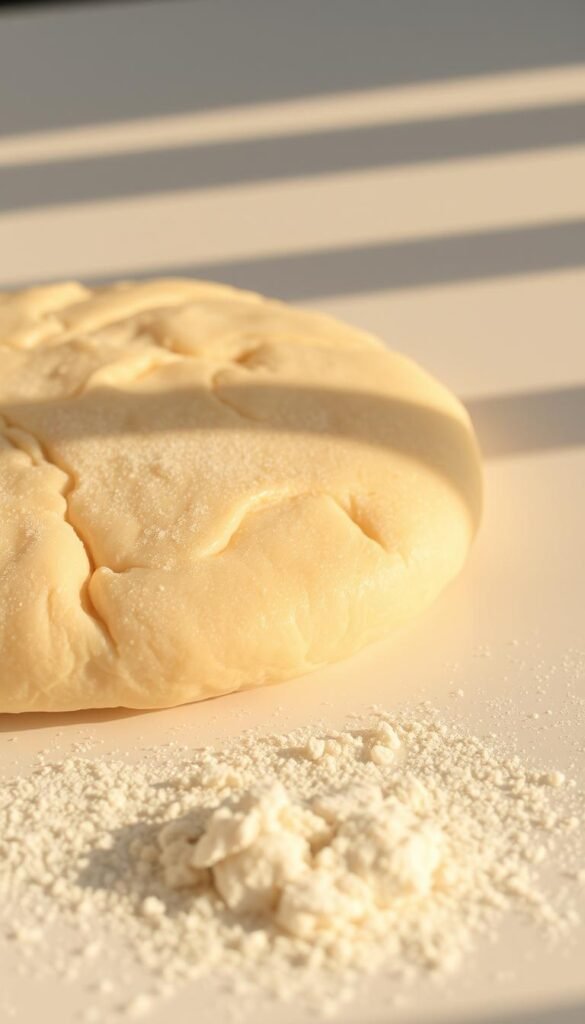
Simple Brown Rice Flour Pizza Base
The Simple Brown Rice Flour Pizza Base is a nutritious and straightforward option for those looking to make gluten-free pizza at home. Using whole grain brown rice flour, this recipe provides a good source of fiber and nutrients.
Ingredients
- 2 cups brown rice flour
- 1/2 cup water
- 1/4 teaspoon salt
- 1 tablespoon olive oil
Preparation Method
- Combine brown rice flour and salt in a bowl.
- Gradually add water and mix until a dough forms.
- Knead the dough for 5 minutes.
- Shape into a circle or rectangle and bake at 425°F (220°C) for 12-15 minutes.
White and Brown Rice Flour Blend Pizza Dough
Blending white and brown rice flours achieves an optimal balance of texture and flavor. This combination offers the lightness of white rice flour and the nutritional benefits of brown rice flour.
Ingredients
- 1 cup white rice flour
- 1 cup brown rice flour
- 1/2 cup water
- 1/4 teaspoon salt
- 1 tablespoon olive oil
Preparation Method
- Mix white and brown rice flours together.
- Add salt and olive oil, then gradually add water.
- Knead for 5-7 minutes until smooth.
- Shape and bake at 425°F (220°C) for 12-15 minutes.
| Flour Type | Texture | Nutritional Value |
|---|---|---|
| White Rice Flour | Light, delicate crust | Lower in fiber |
| Brown Rice Flour | Denser, slightly gritty | Higher in fiber and nutrients |
| White and Brown Rice Blend | Balanced texture | Combines benefits of both |
Crispy Rice Flour Thin Crust
Achieving a crispy thin crust is possible with rice flour. This recipe focuses on techniques to create a cracker-like consistency perfect for thin-crust pizza lovers.
Ingredients
- 2 cups rice flour
- 1/2 cup water
- 1/4 teaspoon salt
- 1 tablespoon olive oil
Preparation Method
- Mix rice flour and salt.
- Gradually add water and olive oil, mixing until a dough forms.
- Roll out thinly and bake at 450°F (230°C) for 8-10 minutes.
Soft and Chewy Rice Flour Pizza Base
For those who prefer a more traditional, bread-like pizza texture, this Soft and Chewy Rice Flour Pizza Base recipe is ideal. It addresses methods for creating a softer crust using rice flour.
Ingredients
- 2 cups rice flour
- 1/2 cup warm water
- 1/4 teaspoon salt
- 1 tablespoon olive oil
- 1 teaspoon sugar
Preparation Method
- Combine rice flour, salt, and sugar.
- Add warm water and olive oil, mixing until a smooth dough forms.
- Knead for 5-7 minutes.
- Bake at 400°F (200°C) for 15-18 minutes.
Rice and Tapioca Flour Pizza Dough
Adding tapioca starch to rice flour improves the elasticity and chewiness of the dough. This Rice and Tapioca Flour Pizza Dough recipe showcases the benefits of combining these two gluten-free flours.
Ingredients
- 1 cup rice flour
- 1/2 cup tapioca starch
- 1/2 cup water
- 1/4 teaspoon salt
- 1 tablespoon olive oil
Preparation Method
- Mix rice flour and tapioca starch.
- Add salt and olive oil, then gradually add water.
- Knead until smooth and elastic.
- Shape and bake at 425°F (220°C) for 12-15 minutes.
These rice flour pizza dough variations demonstrate the versatility and potential of rice flour in gluten-free pizza making. Whether you’re looking for a crispy thin crust or a soft and chewy base, rice flour provides a reliable foundation for delicious gluten-free pizzas.
Chickpea Flour Pizza Creations
Chickpea flour, also known as garbanzo bean flour, is a versatile ingredient for making high-protein pizza crusts with a unique nutty flavor. This ancient ingredient has been used in various cuisines, particularly in Indian and Mediterranean cooking. Its high protein content and nutty taste make it an excellent choice for creating nutritious and delicious pizzas.
Traditional Chickpea Flour Pizza Base
The traditional chickpea flour pizza base is a simple yet flavorful recipe that showcases the natural taste of chickpea flour. This crust is not only gluten-free but also packed with protein.
Ingredients
- 1 cup chickpea flour
- 1/2 cup water
- 1/4 teaspoon salt
- 1 tablespoon olive oil
Preparation Method
- Mix chickpea flour and salt in a bowl.
- Gradually add water, stirring continuously to avoid lumps.
- Add olive oil and mix well.
- Knead the dough for a few minutes until it becomes smooth.
- Roll out the dough into a circle or rectangle shape.
- Bake in a preheated oven at 425°F (220°C) for 15-20 minutes or until crispy.
Mediterranean-Style Chickpea Flour Crust
This Mediterranean-style chickpea flour crust is infused with herbs and spices commonly found in Mediterranean cuisine, such as oregano, thyme, and garlic.
Ingredients
- 1 cup chickpea flour
- 1/2 cup water
- 1/4 teaspoon salt
- 1 tablespoon olive oil
- 1 teaspoon dried oregano
- 1/2 teaspoon dried thyme
- 1 minced garlic clove
Preparation Method
- Mix chickpea flour, salt, oregano, thyme, and garlic in a bowl.
- Gradually add water, stirring continuously.
- Add olive oil and mix well.
- Knead the dough for a few minutes.
- Roll out the dough into a desired shape.
- Bake in a preheated oven at 425°F (220°C) for 15-20 minutes.
Chickpea and Quinoa Flour Blend Pizza
Combining chickpea flour with quinoa flour creates a pizza crust that is not only high in protein but also rich in essential amino acids.
Ingredients
- 1/2 cup chickpea flour
- 1/2 cup quinoa flour
- 1/2 cup water
- 1/4 teaspoon salt
- 1 tablespoon olive oil
Preparation Method
- Mix chickpea flour, quinoa flour, and salt.
- Gradually add water, stirring continuously.
- Add olive oil and mix well.
- Knead the dough for a few minutes.
- Roll out the dough into a desired shape.
- Bake in a preheated oven at 425°F (220°C) for 15-20 minutes.
| Flour Type | Protein Content | Flavor Profile |
|---|---|---|
| Chickpea Flour | High | Nutty |
| Quinoa Flour | High | Mild, slightly nutty |
| Blend | Very High | Balanced nutty flavor |
Herb-Infused Chickpea Flour Pizza Dough
Infusing chickpea flour pizza dough with herbs like basil, rosemary, or oregano can enhance its flavor profile.
Ingredients
- 1 cup chickpea flour
- 1/2 cup water
- 1/4 teaspoon salt
- 1 tablespoon olive oil
- 1 tablespoon chopped fresh herbs (basil, rosemary, or oregano)
Preparation Method
- Mix chickpea flour, salt, and chopped herbs.
- Gradually add water, stirring continuously.
- Add olive oil and mix well.
- Knead the dough for a few minutes.
- Roll out the dough into a desired shape.
- Bake in a preheated oven at 425°F (220°C) for 15-20 minutes.
Crispy Socca-Style Pizza Base
Socca, a traditional French/Italian flatbread, can be adapted into a crispy pizza base using chickpea flour.
Ingredients
- 1 cup chickpea flour
- 1 1/2 cups water
- 1/4 teaspoon salt
- 2 tablespoons olive oil
Preparation Method
- Mix chickpea flour and salt.
- Gradually add water, stirring continuously.
- Add 1 tablespoon olive oil and mix well.
- Let the batter rest for 30 minutes.
- Heat the remaining olive oil in a skillet over medium heat.
- Pour the batter into the skillet and cook until the edges start to curl.
- Transfer to a preheated oven at 425°F (220°C) for 10-15 minutes or until crispy.
“The versatility of chickpea flour makes it an ideal ingredient for pizza creations, offering a delicious and nutritious alternative to traditional pizza crusts.” – Gluten-Free Gourmet
25 Delicious Gluten-Free Pizza Dough Recipes
Exploring beyond traditional gluten-free options, we present five innovative pizza dough recipes that cater to various dietary needs and preferences, ensuring that everyone can enjoy a delicious homemade pizza.
Yeast-Free Gluten-Free Pizza Dough
The yeast-free gluten-free pizza dough is perfect for those with yeast sensitivities or for those who want to skip the rising time. This dough uses a combination of gluten-free flours and leavening agents to produce a crust that’s both crispy and flavorful.
Ingredients
- 2 cups gluten-free flour blend
- 1/2 cup potato starch
- 1/4 cup tapioca flour
- 1 teaspoon salt
- 1 tablespoon sugar
- 1 packet gluten-free baking powder
- 1/4 cup olive oil
- 1 cup warm water
Preparation Method
Combine dry ingredients in a bowl. Mix wet ingredients separately and then combine with dry ingredients. Knead the dough until it forms a ball. Roll out to desired thickness and top with your favorite ingredients. Bake in a preheated oven at 425°F (220°C) for 15-20 minutes or until the crust is golden brown.
Vegan Gluten-Free Pizza Base
This vegan gluten-free pizza base is designed for those who avoid all animal products. It uses a special blend of flours and a flax egg to replace traditional eggs, ensuring a great texture and flavor.
Ingredients
- 1 1/2 cups gluten-free flour
- 1/2 cup coconut flour
- 1/4 cup arrowroot starch
- 1 teaspoon salt
- 1 tablespoon sugar
- 1 flax egg
- 1/4 cup olive oil
- 1 cup warm water
Preparation Method
Mix dry ingredients in one bowl. Prepare the flax egg and mix with other wet ingredients. Combine wet and dry ingredients, then knead until a dough forms. Roll out the dough, top with your favorite vegan ingredients, and bake at 425°F (220°C) for 15-20 minutes.
Paleo-Friendly Sweet Potato Pizza Crust
The paleo-friendly sweet potato pizza crust leverages the natural sweetness and binding properties of sweet potatoes, making it a great grain-free option.
Ingredients
- 2 large sweet potatoes, cooked and mashed
- 1/4 cup coconut flour
- 1/4 cup arrowroot starch
- 1/2 teaspoon salt
- 1 tablespoon olive oil
Preparation Method
Mix mashed sweet potatoes with other ingredients until a dough forms. Knead lightly and shape into a circle or rectangle. Top with paleo-friendly toppings and bake at 400°F (200°C) for 20-25 minutes or until the crust is set and toppings are cooked.
Oat Flour Pizza Dough
Oat flour pizza dough offers a delicious and fiber-rich alternative. It’s perfect for those looking for a slightly different flavor profile and texture.
Ingredients
- 2 cups oat flour
- 1/2 cup tapioca flour
- 1/4 cup coconut sugar
- 1 teaspoon salt
- 1 packet active dry yeast (gluten-free)
- 1 cup warm water
- 1 tablespoon olive oil
Preparation Method
Combine dry ingredients. Mix wet ingredients and then combine with dry ingredients. Knead until a smooth dough forms. Let it rise, then punch down and shape into a pizza crust. Top with your favorite ingredients and bake at 425°F (220°C) for 15-20 minutes.
Quinoa Flour Pizza Base
Quinoa flour pizza base is not only gluten-free but also packed with protein, making it a nutritious choice. It has a slightly nutty flavor that pairs well with a variety of toppings.
Ingredients
- 2 cups quinoa flour
- 1/2 cup potato starch
- 1/4 cup tapioca flour
- 1 teaspoon salt
- 1 tablespoon olive oil
- 1 cup warm water
Preparation Method
Mix dry ingredients. Combine wet ingredients and then mix with dry ingredients. Knead until a dough forms. Roll out to desired thickness, top with your favorite ingredients, and bake at 425°F (220°C) for 15-20 minutes or until the crust is golden.
Tips for Gluten-Free Pizza Success
Achieving success with gluten-free pizza requires more than just a great recipe; it demands a deep understanding of the nuances involved in working with gluten-free dough. Mastering the techniques for handling, baking, and storing gluten-free pizza dough is crucial for producing high-quality pizzas.
Proper Dough Handling Techniques
Handling gluten-free dough can be challenging due to its delicate nature. To overcome this, it’s essential to let the dough rest for the recommended time to allow the flours to hydrate fully. When shaping, use a gentle touch to prevent the dough from tearing. For sticky doughs, a light dusting of flour or cornstarch can help. Transferring the dough to a preheated surface or pizza peel dusted with cornmeal can prevent sticking and ensure a smooth transfer to the oven.
Baking Methods for Perfect Texture
Achieving the perfect texture is a critical aspect of gluten-free pizza making. Preheating the baking surface, whether it’s a pizza stone or a baking steel, is essential for a crispy crust. Consider using a par-baking method where the crust is partially baked before adding toppings to prevent sogginess. The temperature and rack positioning in your oven also play a significant role; a hot oven with the rack positioned in the middle or lower third can help achieve a well-cooked crust.
Storage and Freezing Guidelines
For those who like to plan ahead, gluten-free pizza dough can be made in advance and stored or frozen. After the dough has risen, it should be cooled completely before being wrapped tightly in plastic wrap or aluminum foil. For freezing, place the wrapped dough in a freezer-safe bag, removing as much air as possible before sealing. When you’re ready to use it, simply thaw the dough in the refrigerator overnight or at room temperature for a few hours. Reheating should be done at a moderate temperature to prevent burning.
Conclusion
Gluten-free pizza making has come a long way, offering a variety of gluten-free pizza options that cater to different tastes and dietary needs. From celiac-friendly recipes to wheat-free pizza alternatives, the possibilities are endless. The diverse range of recipes provided accommodates various additional dietary needs, including keto, paleo, vegan, and allergen-free options.
The best gluten-free pizza dough is not just about replacing wheat flour; it’s about exploring new flavors and textures. By experimenting with different flour combinations and techniques, you can discover your personal favorite. Many of these alternative crusts provide more nutrition than traditional wheat-based options, making them a healthier choice.
Sharing homemade gluten-free pizza with friends and family creates inclusive dining experiences where everyone feels welcome. We invite you to share your experiences, modifications, and success stories with these recipes, fostering a sense of community around gluten-free cooking.
With the knowledge and inspiration gained from this article, you’re ready to start your gluten-free pizza making journey. Enjoy exploring the world of gluten-free pizza and discover the joy of cooking for everyone.



